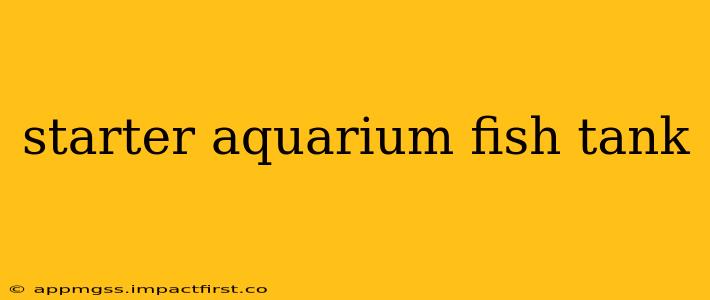So, you're ready to dive into the fascinating world of aquariums! Starting a freshwater aquarium can be incredibly rewarding, but choosing the right starter fish is crucial for success. This guide will walk you through everything you need to know, from selecting the perfect tank mates to ensuring their long-term health and happiness. We'll even tackle some frequently asked questions to help you avoid common beginner pitfalls.
Choosing the Right Aquarium Size
Before even thinking about fish, you need to select the right-sized aquarium. A larger tank is generally easier to maintain stable water parameters, crucial for the health of your fish. For beginners, a 10-20 gallon tank is a great starting point. Smaller tanks are more challenging to maintain stable conditions, making them less ideal for beginners. Remember, bigger is usually better when it comes to aquarium keeping.
What are the Best Starter Fish for Beginners?
This is a key question, and the answer isn't one-size-fits-all. The best starter fish are hardy, relatively low-maintenance, and peaceful. Here are a few excellent choices:
- Harlequin Rasboras: These schooling fish are active, colorful, and relatively undemanding. Keep at least six in a school for optimal health and behavior.
- Neon Tetras: Another popular schooling fish, neon tetras bring vibrant color to your tank. Again, a school of at least six is recommended.
- Platyfish: Livebearers like platies are relatively easy to care for and come in a variety of beautiful colors.
- Guppies: Another popular livebearer, guppies are hardy and readily adapt to various water conditions.
- Corydoras Catfish: These bottom-dwelling scavengers help keep your tank clean and are peaceful additions.
How Many Fish Can I Put in My Tank?
The "one-inch-of-fish-per-gallon" rule is a common guideline, but it's an oversimplification. Factors like fish size (adult size!), activity level, and waste production vary greatly between species. It's better to research the specific needs of your chosen fish and overestimate rather than underestimate their space requirements. A good rule of thumb is to start with fewer fish than you think you can handle and add more gradually as your experience grows.
What Kind of Aquarium Equipment Do I Need?
Besides the tank itself, you'll need several essential pieces of equipment:
- Filter: A good filter is critical for maintaining water quality. Choose a filter appropriate for your tank size.
- Heater: Unless you live in a tropical climate, you'll need a reliable heater to maintain the optimal temperature for your fish.
- Substrate: This is the material at the bottom of your tank. Gravel or sand are common choices.
- Lighting: Proper lighting is essential for plant growth (if you choose to have live plants) and the overall aesthetic of your tank.
How Often Do I Need to Clean My Aquarium?
Regular maintenance is key to a healthy aquarium. This includes:
- Partial Water Changes: Perform partial water changes (25-50%) weekly or bi-weekly to remove waste and maintain water quality.
- Cleaning the Filter: Clean or replace filter media according to the manufacturer's instructions. Avoid cleaning the entire filter at once, as this can disrupt the beneficial bacteria colonies that break down waste.
- Cleaning Algae: Regularly remove algae from the glass and decorations as needed.
What are the Signs of a Sick Fish?
Recognizing the signs of a sick fish early on is crucial. Common signs include:
- Lethargy: A fish that is unusually inactive or lethargic may be sick.
- Loss of Appetite: If a fish stops eating, it's a clear warning sign.
- Unusual Swimming Patterns: Erratic swimming or difficulty staying upright can indicate illness.
- Visible Physical Changes: Look for unusual spots, discoloration, or other physical abnormalities.
How do I Cycle my Aquarium?
Cycling your aquarium is a crucial step before adding fish. This process establishes beneficial bacteria colonies that break down harmful ammonia and nitrite produced by fish waste. There are several methods for cycling an aquarium, including the fishless cycling method. Proper cycling is essential for preventing fish diseases and death. Research this process thoroughly before adding any fish.
By carefully considering these points and doing your research, you can create a thriving and beautiful aquarium and enjoy the peaceful, captivating hobby of fishkeeping. Remember that patience and attention to detail are key to success in the wonderful world of aquariums!
